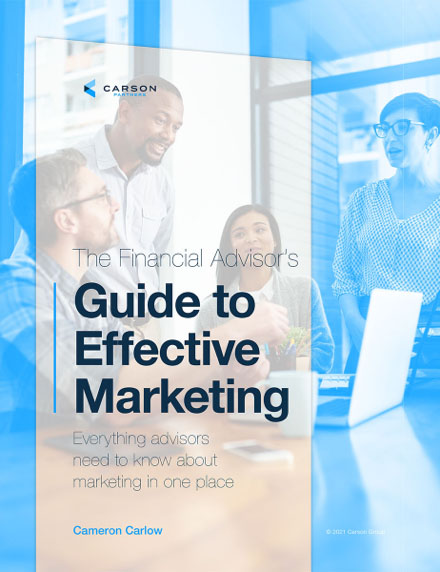When you think about content marketing for financial advisors, one of the first things that springs to mind is blogging. Blogs can be a valuable tool to help you to demonstrate industry knowledge and establish your credibility; educate investors and build trust; attract and generate leads; and increase website traffic.
But those upsides don’t automatically come with clacking out a few paragraphs and hitting publish between client meetings.
To see results, advisors must know how to write about financial planning content effectively. In this article, we’ll go over how to leverage blogging to help your clients – existing and potential – and to bolster your content marketing efforts.
Know Your Audience
Who are you writing for?
No, the answer shouldn’t be “investors.” The answer should be more specific. The answer is your personas.
Personas – most advisors have three to five – represent your ideal clients.
Nearly all financial advisors have some version of a persona that is focused on retirement income planning. So if you’re focused exclusively on high net worth earners nearing retirement, you wouldn’t blog about how to open a retirement account, right?
When blogging, think of your personas and ask yourself these questions:
- What does this persona need?
- How can you attract this persona?
- What would repel this persona? (Now you know what to avoid.)
Don’t worry about writing for clients versus prospects – the two should mirror each other, because they should both fall into one of your persona categories.
Identify Your Blog’s Key Message
You can pick a topic easily. Estate planning. Roth conversions. Tax-loss harvesting.
But that’s not enough.
If you haven’t outlined your blog beyond one word or phrase, you’re going to water down your message – because you don’t really have one.
Writing is more difficult when you give yourself too many options. That lack of direction will quickly become clear – or rather, confusing – to readers who will feel just as lost and then quickly navigate away from your website.
Think back to the essays you wrote during your school years when you would:
- Identify your topic.
- Write a thesis statement.
- Identify your supporting points.
These principles apply to blog writing, too, and provide valuable structure.
How to Organize Your Blog
When you sit down to write, a blank computer screen seems to mock you each time the cursor blinks. But once you identify your topic, write a thesis statement and identify your supporting points, you’re in much better shape to start. You have a framework to follow.
Each supporting point can essentially function as a blog subsection. Breaking down a blog this way keeps you organized.
Headers also tell your audience exactly what they’re going to get as they scan the page, which helps entice them to start reading and, importantly, keep reading. This strategy acknowledges and maximizes our notably short attention spans in the age of social media and endless scrolling.
To be effective, headers should be direct. Now is not the time for creativity; do not risk obscuring your message among potential readers or with Google, which would interfere with your search results.
It’s also key that you:
- Look for opportunities to use bullet points. (Remember those short attention spans?)
- Link to related blogs and resources – think fact sheets, checklists, calculators and webinars.
Financial planning content you’ve already created should expand on points within your blog. And the more time readers spend engaging with your website, the more likely they are to engage with you directly.
- End your blog with a CTA, or call to action.
Now that you’ve established yourself as a credible source, invite the reader to set up a complimentary call, subscribe to your newsletter or download a resource. They might not take the action if this is the first time they’ve visited your site, but it’s important you facilitate every opportunity to connect.
Don’t make them go hunting for a contact form elsewhere on your website by not including a CTA; odds are, they won’t take the time.
How to Write Engaging Financial Planning Content
People are coming to your blog because they want to know something and believe you have an understanding that they do not. They will keep coming to you if, when they’re done reading your blog, they come away with a deeper insight.
By using conversational language when writing out financial planning content, you can communicate more effectively.
The weekend is here, the air is crisp, the coffee is hot. Before you turn on the pancake griddle, you open your front door to retrieve the Sunday newspaper. Your neighbor has the same idea.
“I’m seeing headlines about new tax legislation,” he calls out across the driveway, pointing to the front page. He knows you’re an advisor. “What’s that about?”
You probably wouldn’t recite the language of the bill or speak about it the same way you would to your peers at Excell.
Instead, you might say: “Some of the changes will raise taxes on people with a high income – if you make more than $400,000, you’ll want to start thinking about Roth conversions. But most families won’t be affected.”
It’s conversational and succinctly outlines the likely impact on everyday people. That’s what your clients and prospects are looking for.
[Complimentary download: The Advisor’s Guide to Effective Marketing]
Don’t rely on jargon and academic speak more fitting for a research project. That style of writing doesn’t make you seem smart – it makes you seem inaccessible.
If readers feel lost every time you send a newsletter and potential leads need to pop open a Google tab when they open your blog, they’re going to get frustrated and move on. We don’t have to tell you that a frustrated client is bad for business.
That doesn’t mean you need to avoid appropriate industry terms when blogging. It means you should reference industry terms when necessary and in a way that makes sense to your personas.
Remember, we make the complex simple. We help clients understand what’s happening with their money at every stage of their financial journey. The same principle applies when you’re blogging.
How to Use Personal Anecdotes in Your Blog
Thoughtful anecdotes can serve a dual purpose. They can reinforce and bring to life your message. You’re showing, not just telling – that packs a bigger punch.
Anecdotes can also help readers get to know you – you’re building relationships from a distance. As you know, relationship-building goes far in the financial services industry.
But using anecdotes is a delicate proposition – it’s easy for an anecdote to morph into a diary entry. That’s where financial advisors often go wrong.
You can avoid this by keeping it short. Limit your anecdote to no more than five or six sentences. If you use more than one anecdote in your blog, make sure you don’t stack them on top of each other. And to keep Google happy, don’t lead with a lengthy anecdote. Lead with keywords.
Blog with Keywords
Keywords are specific phrases or questions that your personas would use when searching for financial advice. Examples include “When to claim Social Security,” “When can I retire?” or “How much money do I need to retire?”
As you’re writing, be intentional in including your applicable keyword(s) in the blog title, your headers and your first paragraph in particular. But be mindful to not overdo it. Google’s bots watch out for this practice, known as “keyword stuffing.” Readability is your first priority.
Start Writing
If you follow these guidelines, you’re well on your way to writing financial planning content that demonstrate your industry knowledge, establish your credibility, educate readers, build trust and attract leads. These are the types of blogs that will strengthen your content marketing strategy.
Want to know more about what’s driving the success of today’s fastest-growing financial advisors? Subscribe to Carson’s newsletter, The Trend Line.


